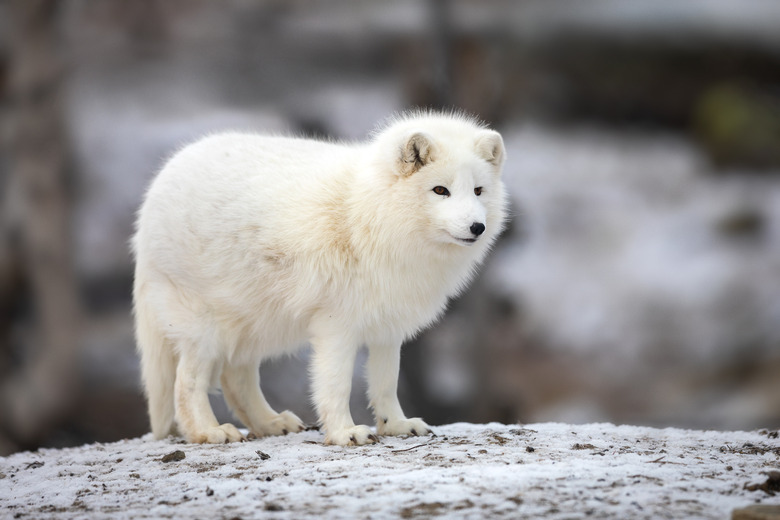Facts On The White Fox
The white fox, also called the Arctic fox, is an animal found in some of the coldest and harshest environments in the world. These foxes have developed adaptations that are unique compared to other fox species that allow them to survive in the cold and dry areas they call home.
White foxes have also evolved specific adaptations that allow them to successfully find and hunt for food in extreme temperatures and heavy snow.
Classification and Description
Classification and Description
The white fox (Vulpes lagopus) is also called the Arctic fox, the polar fox and the snow fox. Arctic foxes are a part of the kingdom Animalia and the Canidae (or canine) family. This means they're not only related to other species of fox like the red fox, but they're also a part of the family that includes dogs, wolves, dingos and coyotes.
Named for its bright white coat, the color of these foxes can also sometimes appear as a blue-grey coloration. The white coat allows them to easily blend in to the ice and snow of their environment, which helps them both capture prey and avoid predation. In the spring and summer, the coat of the white fox becomes grayish brown. This allows them to continue to blend into the darker environment of rocks and dirt that appears in the spring/summer months in the tundra.
These foxes are known for their playful and energetic personalities, often reminding people of playful puppies or kittens. They're quite small even for foxes with a weight range from 6 pounds to around 17 pounds at most and only measuring 0.2-0.3 feet tall and 2-3 feet in length.
These foxes can live up to 14 years, but the average lifespan in the wild is between 3 and 6 years. They've evolved to be able to withstand the freezing temperatures in the arctic and can live in temperatures as low as –94 degrees Fahrenheit.
Reproduction
Reproduction
White foxes are monogamous, which means that they usually mate for life. The breeding season is in the spring usually around April and May.
The female fox will give birth to a litter of pups that can range from six to 19 pups. The pups are cared for by both parents with the female caring for them in a den while the male hunts for food for both mom and pups.
White Fox Habitat
White Fox Habitat
As the name Arctic fox suggests, most of their geographical range is in the Arctic tundra. They're native and live in Arctic areas in the Northern Hemisphere, ranging from areas of Alaska to Canada in North America, as well as ranges in Russia, Greenland, Iceland, Northern Asia and Scandinavia. White foxes are actually the only land mammals that are native to Iceland.
While most white foxes in these Arctic environments live directly in the open ice and snow, some also live in boreal forest (or taiga) environments as well in areas of Canada and Alaska.
White Fox Hunting and Diet
White Fox Hunting and Diet
Arctic foxes are omnivores, which means they eat both animal and plant foods. Common prey species for the white fox include:
- Small rodents.
- Lemmings.
- Voles.
- Arctic hare.
- Rabbits.
- Seal pups.
- Birds.
Arctic foxes will also eat eggs they find along with small fish. They've also been observed scavenging polar bear leftovers. Sometimes they'll follow behind polar bears at a safe distance before descending on any remains of animals that the bears leave behind.
Arctic foxes will also eat berries, vegetables and other plant matter, especially when meat or decaying animals are scarce.
These foxes have learned to hunt in a unique way. Many of the species they hunt burrow under the snow for warmth and protection. The white fox will use its large and sensitive ears to listen for movement under the ground. Then, it will jump and pounce in order to break through the snow and capture its prey.
Predators
Predators
White foxes are preyed on by large animals in the area, including polar bears and wolves. Humans are also a predator of these foxes with many people hunting them for their furs.
Cite This Article
MLA
Walsh, Elliot. "Facts On The White Fox" sciencing.com, https://www.sciencing.com/white-fox-6732239/. 22 November 2019.
APA
Walsh, Elliot. (2019, November 22). Facts On The White Fox. sciencing.com. Retrieved from https://www.sciencing.com/white-fox-6732239/
Chicago
Walsh, Elliot. Facts On The White Fox last modified August 30, 2022. https://www.sciencing.com/white-fox-6732239/
